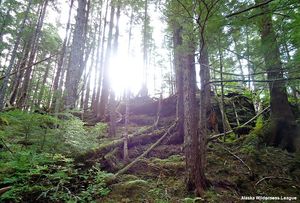Difference between revisions of "Tongass National Forest"
| Line 6: | Line 6: | ||
|- | |- | ||
| | | | ||
| − | *Total Acreage | + | *'''Total Acreage:''' 16.8 million |
| − | *Protection History | + | *'''Protection History:''' Created September 10, 1907, when the Tongass National Forest was created via presidential proclamation by President Theodore Roosevelt . In July 1908, the Tongass was combined with the Alexander Archipelago Forest Reserve (created August 20, 1902). Additional proclamations were made in February 1909 and June 1925, bringing the Tongass to its current size. |
| − | *Most Recent | + | *'''Most Recent Development:''' Roadless Rule Exemption Review Process. As of September 2018, the U.S. Forest Service is evaluating a state-specific Roadless Rule as requested by the state of Alaska. |
| − | *Threats | + | *'''Threats:''' A Roadless Rule rollback and/or exemption for the Tongass could re-start wide scale clearcutting of old-growth logging. Additionally, land transfers to private corporations could fragment the forest even further. |
| − | *Climate Change | + | *'''Climate Change:''' Rising temperatures and warming waters threaten Southeast Alaska salmon runs. The Tongass is also one of the world’s greatest carbon sinks, as its old-growth trees sequester amazing amounts of carbon in the soil. |
| − | *Wildlife | + | *'''Wildlife:''' Five species of Pacific Salmon, humpback and orca whales, otters, beavers, wolves, deer, plus some of the largest concentrations of brown bears and bald eagles in America. |
| + | |||
|- | |- | ||
Revision as of 09:33, 1 October 2018
| KEY FACTS |
|
At 17 million acres, the Tongass National Forest is America’s largest national forest, encompassing the majority of the southeast Alaska panhandle. Each year more than 1 million people come to experience glaciers flowing from the mountains into the sea and iconic wildlife that thrives in one of the largest remaining temperate rainforests in the world.
Alaska’s national forests were included in the Roadless Rule — with overwhelming support from commenters — expressly because forest wildlands persist in Alaska on a scale unknown elsewhere in the country. In addition to harboring great natural beauty and iconic wildlife, federal scientists found that retaining the intact roadless areas of the Tongass is a “key element” in sustaining the region’s extraordinary salmon runs (and their commercial, subsistence, and recreational fisheries). Unfortunately, through legislation and regulatory rollbacks, the Alaska delegation and the current administration are attempting to remove, modify, and/or exempt roadless protections for the Tongass National Forest.
At the end of the Obama administration, the USFS approved the Tongass Land Management Plan (TLMP) slowly moving the Tongass away from taxpayer-subsidized, industrial-scale old-growth logging, long since abandoned elsewhere in the national forest system. Despite strong public support and scientific backing, the Alaska delegation, similar to the Roadless Rule, has been attempting to reverse and weaken protections guaranteed by the TLMP through riders in must-pass legislative vehicles and stand-alone legislation.
The only legislation that should be pursued to truly protect the Tongass are those that would codify the Roadless Rule and sustain the TLMP parameters as established in 2016, not weaken or reverse them. Please see below for relevant legislation, talking points, fact sheets, and more on what we're doing to defend the Tongass National Forest.
Fact Sheets | Public Letters | Maps | Research & Reports
Recent Legislative Activity
- S. 3333, Roadless Area Conservation Act of 2018
- This bill would provide lasting protection for inventoried roadless areas within the National Forest System.
- To cosponsor: email Bryan Petit (mailto:Bryan_Petit@energy.senate.gov) on Sen. Cantwell's (D-WA) Energy and Natural Resources Committee staff.
- H.R. 2, 2018 Farm Bill
- H.Amdt598 from Rep. Don Young (R-AK-1) would exempt all National Forests in Alaska from the Roadless Rule.
- S. 1481, Alaska Native Claims Settlement Improvement Act
- From Senator Murkowski (R-AK), this bill contains numerous provisions that would circumvent the 1971 Alaska Native Claims Settlement Act (ANCSA) by removing important checks and balances, especially with regard to some of Alaska’s most high quality public lands within the Tongass National Forest and the National Wildlife Refuge System.
- H.R. 1867/S. 785, Alaska Native Veterans Land Allotment Equity Act
- From Rep. Don Young / Sen. Sullivan (R-AK), this bill would allow the transfer of nearly half a million acres of public land into private ownership, carving up Alaska’s most valuable public lands and creating thousands of inholdings in national wildlife refuges, wilderness areas and national forests.
Talking Points
- Opening up the Tongass National Forest roadless areas to road building and logging would threaten the abundant wildlife and beautiful scenery essential to tourism in Southeast Alaska, an industry that contributes more than $1 billion dollars to the region each year and accounts for 15 percent of the region’s employment.
- The Roadless Rule is the result of one of the most extensive public processes in U.S. history – more than 1.6 million people submitted comments on the rule, and 95% of those commented favorably on roadless protections.
- Southeast Alaska can move forward with the TLMP Amendment. Built on the consensus of Alaskans, the amendment supports prioritizing premiere salmon watersheds and other essential conservation lands, and shifting our priorities to meet the needs of all southeast Alaskans, not just the timber industry.
Fact Sheets
- Alaska Native Veterans Land Allotment Equity Act
- TLMP Amendment of 2016
- Roadless Area Conservation Rule
- Millions of Acres at Risk in the Tongass
Public Letters
- Letter from Scientists to the USFS Supporting Roadless Rule Protection in the Tongass, September 2018
- Environmental Community Opposition Letter to Alaska Native Claims Settlement Improvement Act (S. 1481), January 2018
- Letter from Business Owners, Guides, Outfitters, Hunters and Anglers Supporting Tongass 77
- Environmental Community Opposition Letter to Alaska Native Veterans Land Allotment Equity Act (S. 785), July 2017
